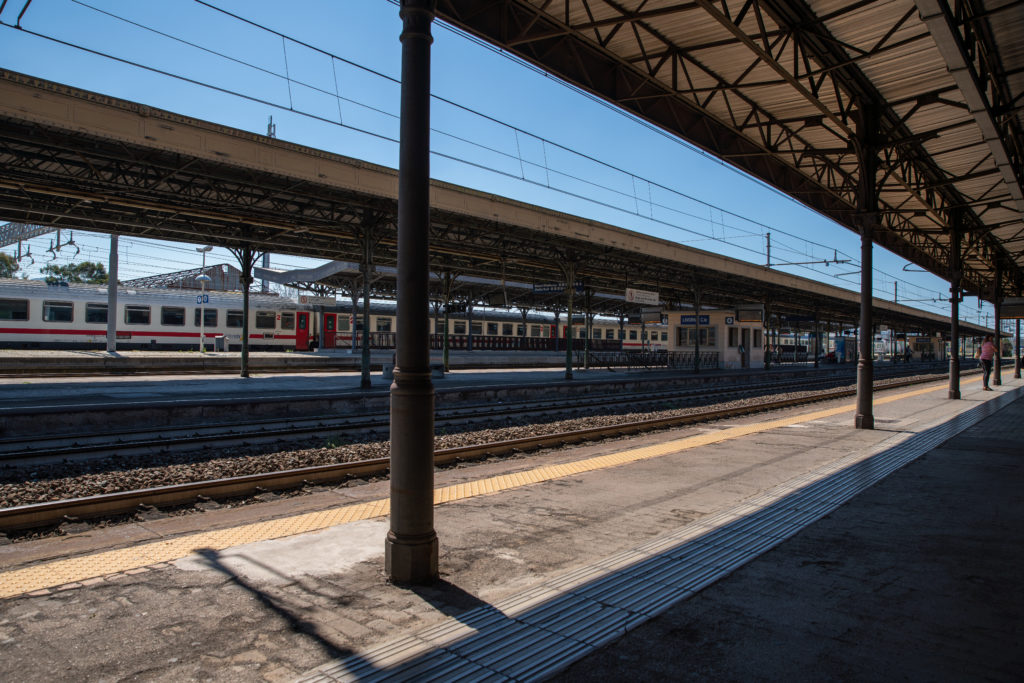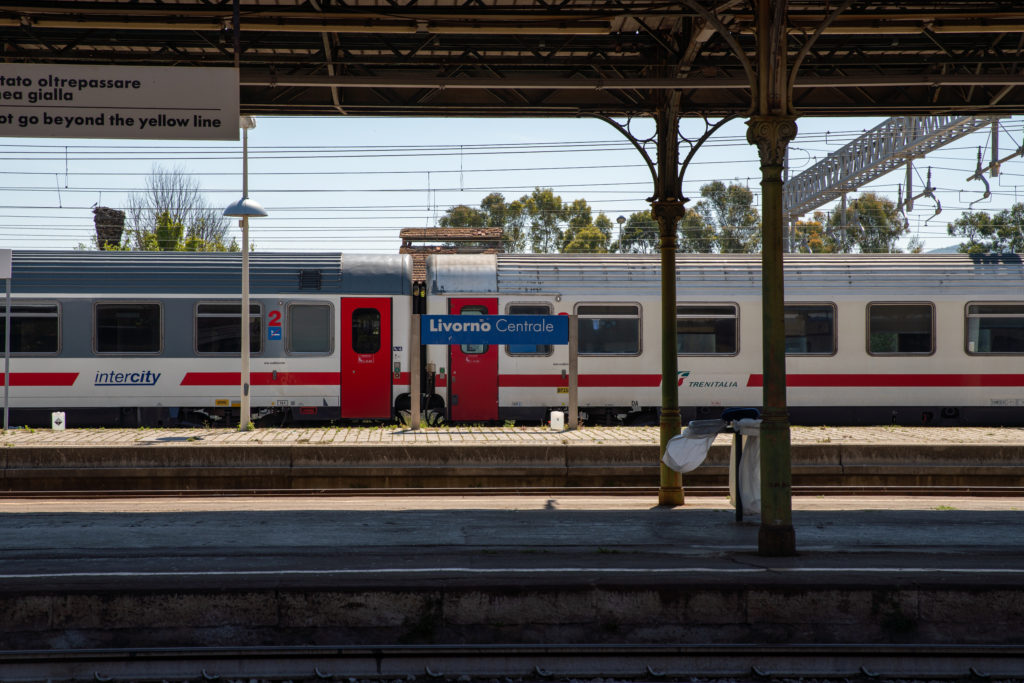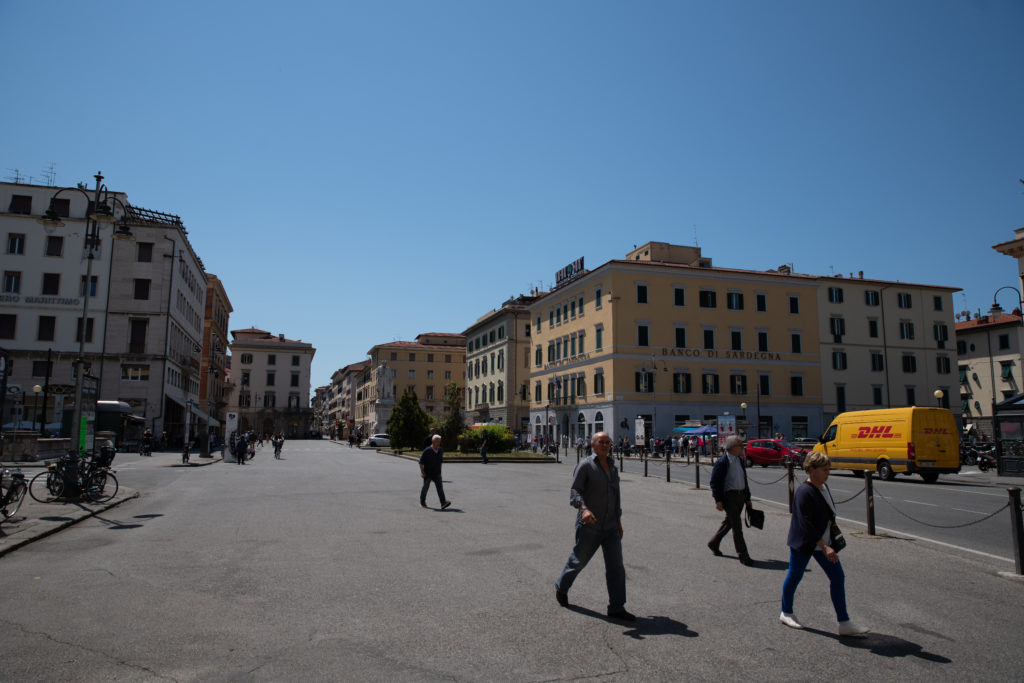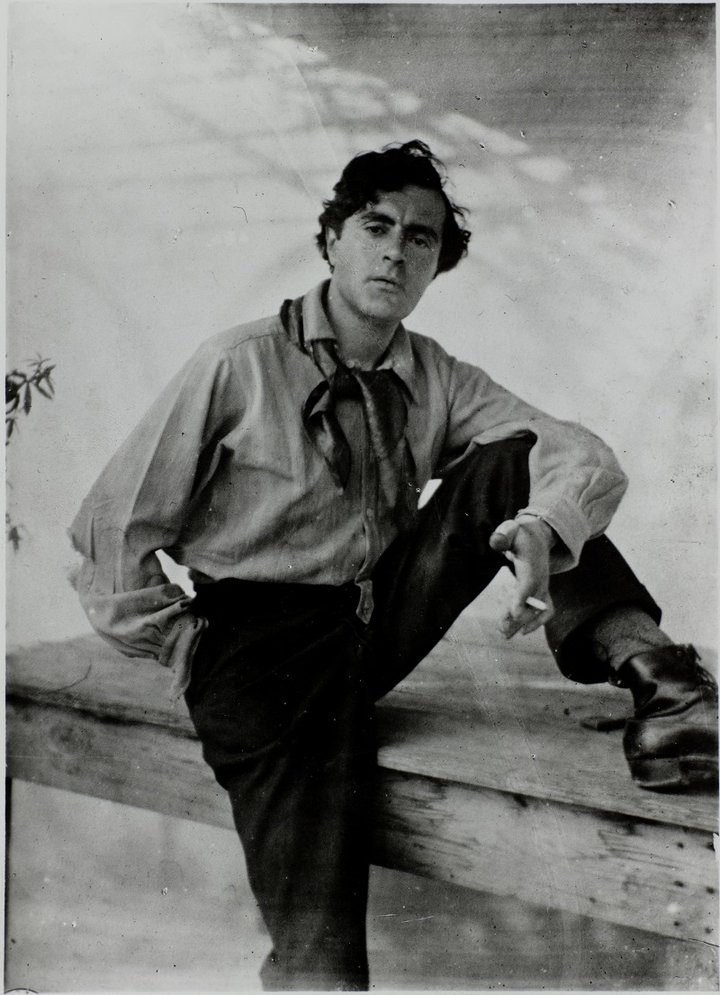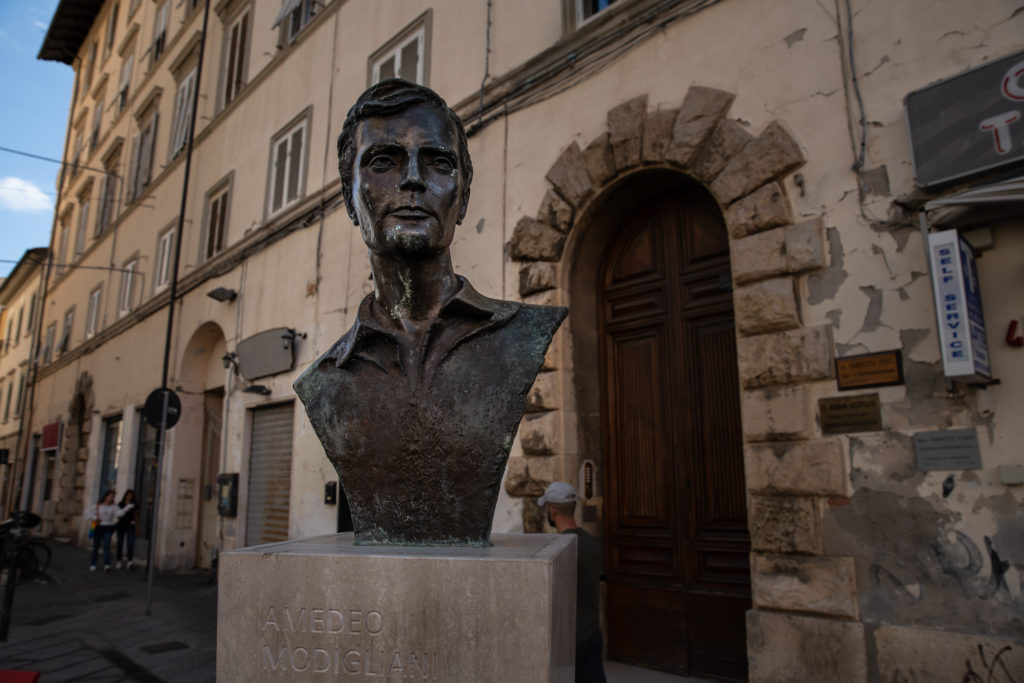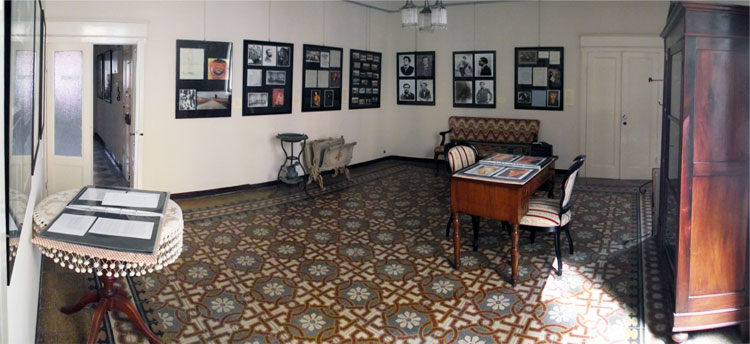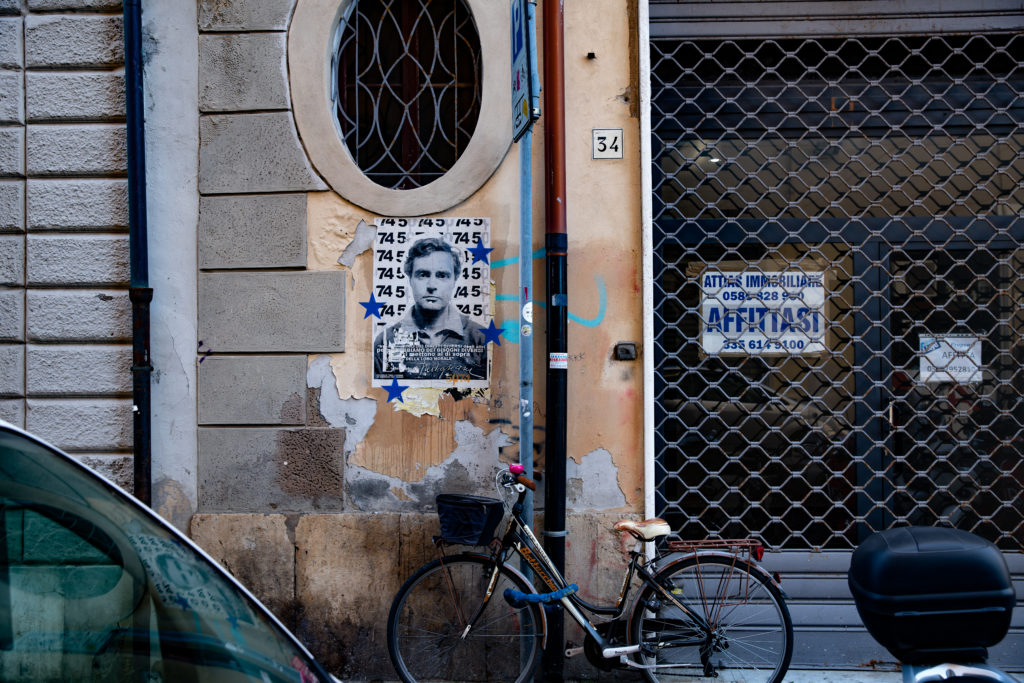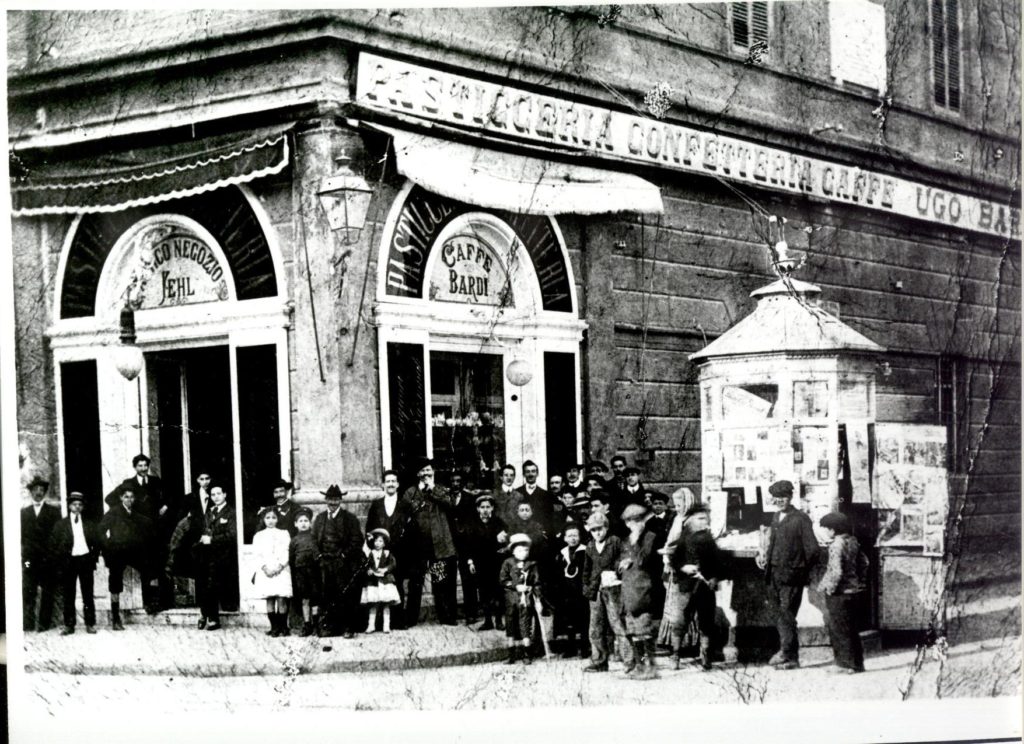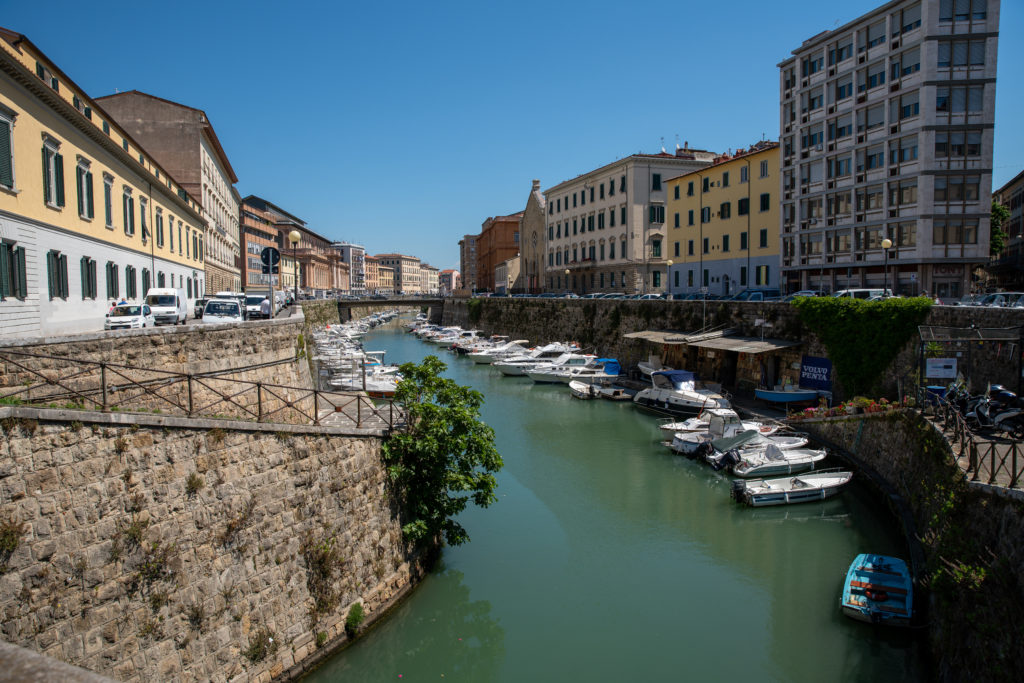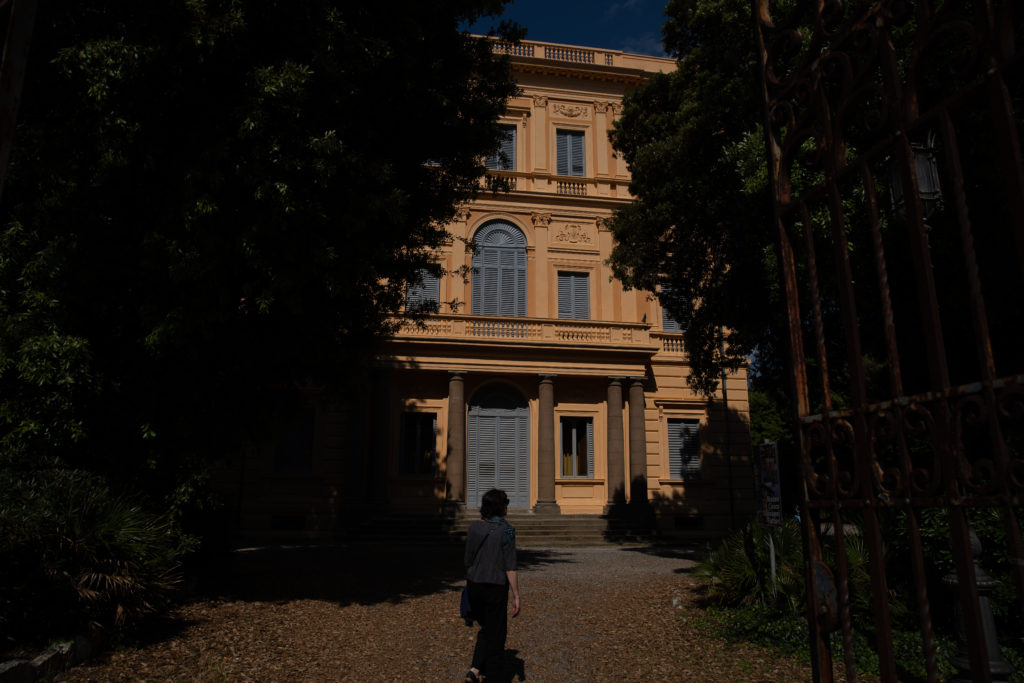Do you know about Amedeo Modigliani? He was one of Italy’s great Artists and we love his Art so much that we travelled all the way to his birthplace in Livorno to discover where he grew up. If you ever come to this quiet windswept, seaside town on the Ligurian Sea you can follow our steps and take a tour of the important traces that remain from his life.
Livorno’s deserted central station, a far cry from the tourist madness of Florence.
On our way out to the bus station who do we find but the great man himself! The Livornese are justifiably proud of their famous artist.
Not many tourists visit Livorno except when a cruise ship docks and busloads of perspiring Americans are shuffled off to the “Must See” destinations of Florence and Pisa, which makes it all the more special and magical to walk the long sun drenched streets.
If you are lucky you will see that the bohemians still gather in Livorno, here a group of Italian hippies have met to sing and play their instruments in the gazebo on the seashore.
Modigliani (or Dedo as he was affectionately known by his family) was the epitome of a tragic artist. Born to a bourgeois Jewish family in Italy, he later shunned his academic upbringing and willingly devolved into a poverty stricken vagabond. He was formally educated as a life painter in his teens, quickly developing a life-long infatuation with nudes. In 1902 he moved to Florence to study at the Academia di Belle Arti, at the “Free School of Nude Studies,” and a year later he moved to Venice as a fledgling artist, where he smoked hashish for the first time. It was only after he discovered narcotics that he developed the philosophical belief that the only path to creativity was through defiance of social norms and disorder in life. Thus began a life long affliction with corrupted beauty, which would ultimately end with his untimely death and the tragic suicide of his grief-stricken wife, Jeanne Hébuterne and their unborn child. Their only daughter was left an orphan at only 14 months age.
Modigliani contracted tuberculosis at an early age, which may be one reason why he often engaged in self-destructive behaviour. Living in Paris, he had affairs with many women, drank heavily, smoked hashish, and drank absinthe. He would often strip naked at social gatherings. He railed against all of the excesses of a Bourgeois lifestyle, and stripped them from his life, even destroying paintings that he had made in his earlier years.
Although he purposely created a life in which chaos, poverty, and doom lurked in every corner, he was a prolific artist. He sketched furiously, sometimes drawing over 100 sketches in a day, but many of his works were either lost, given away, or in some cases, destroyed by Modigliani himself. His favorite subject was by far the human form, painting the likenesses of other artists, such as Pablo Picasso, Diego Rivera, Max Jacob, and Juan Gris, who all sat for the artist. His formal works are characterised by an elongation of the human form and mask-like faces, and his work is so unlike any other of his time that it still defies classification.
” I would like my life to be like a rich river flowing joyfully on Earth “- Amedeo Modigliani –
The Tour
First stop on our tour is the birthplace of Modí, You will find it at Via Roma number 38, ring the bell beside the unassuming door and Elissa will admit you. If you are having trouble finding it look for this bust near the Piazza Attias, If you are facing the bust you are looking towards Casa natale Amedeo Modigliani.
Modigliani was famously born on the day the bailiffs arrived to take possession of the family valuables as an economic downturn in the price of metal had plunged the Modiglianis into bankruptcy. Amedeo’s birth saved the family from ruin; according to an ancient law, creditors could not seize the bed of a pregnant woman or a mother with a newborn child. The bailiffs entered the family’s home just as Eugenia went into labour; the family protected their most valuable assets by piling them on top of her. Modigliani’s resourceful mother later used her social contacts to establish a school and, along with her two sisters, made the school into a successful enterprise, Elissa will show you a photograph of a young Amedeo with his classmates in the backyard of the house.
 Elissa stands at her desk in the kitchen of Casa natale Amedeo Modigliani
Elissa stands at her desk in the kitchen of Casa natale Amedeo Modigliani
Second stop not far from the home of Modigliani you will find his high school, Elissa will have shown you his school reports, he did well in French thanks to his French speaking Mother but not so good on comportment, he was an energetic and rather spoilt child. The school is at Via Ernesto Rossi 6 and is one of the oldest schools in Livorno.
Third stop stroll on along Piazza Cavour and cross the canal.
We come to the former location of Caffè Bardi, from 1908 until it closed in 1927 it was the gathering place of bohemian Artists, Poets and Musicians from all over the World, it is now occupied by a Danish stationary shop.
Fourth stop continue now along the Medici canal until you come to the large and beautiful Mercato Centrale (covered market) it’s not far. On the first floor of the Market building Modigliani had his studio.
Up these unassuming steps was once the studio of Amadeo.
Most people know Amadeo for his paintings but in fact he really wanted to be a sculptor.
Unfortunately the dust and shavings irritated his tuberculosis too much but the strong symbols of his African influenced sculpture remain in his paintings, the long necks and noses, the concept of the mask and the blind eyes. Modigliani famously said “When I know your soul, I will paint your eyes” and in fact of all his paintings of the beautiful Jeanne Hébuterne only the final one shows her blue eyes.
Amadeo’s sculptures were not well received by the pompous and conservative art critics of his time which according to legend led him to angrily throw three of them into the canal that runs past the market.
This gave rise to a wonderful prank and scandal that beautifully targeted some more modern art critics. In 1984, 100 years after the birth of Modigliani, Vera Durbé, the manager of Livorno’s Progressive Museum of Contemporary Art, decided to organise an exhibition of Modigliani’s sculptures, to celebrate his 100th year. Her idea, however, prompted an interesting challenge: The search for the legendary heads that had famously been thrown into the canal by a young Modi. The quest was supported by the administrative council, who approved the dredging of the canal. The excavation work took place under the watchful eyes of many who stood waiting excitedly for any news of the recovery of these long-awaited works of art. Their wait lasted a week and on the eighth day three stone sculptures, sculpted in the harsh, elongated style for which Modigliani was by now famous for, were successfully excavated, one after the other. They were presented to the many art critics of Livorno, who unanimously declared that the heads were the original work of Modigliani. Only Amadeo and Jeanne’s orphaned daughter raised any doubts, denying that they were her Father’s work but no one listened to her. Durbé’s dream was realised and art lovers from all over the world flocked to Livorno… but they had forgotten that Livorno is a city famous for its pranks and practical jokes, after a month of much self congratulation and awards regarding the three newly-recovered sculptures, three Livornese students: Pietro Luridana, Pierfrancesco Ferrucci and Michele Guarducci, came forward claiming to have sculpted one of the three heads, in the garden of one of their houses, using drills and other tools bought from a local hardware store. They presented photos of themselves in action and the splinters of stone pertaining to the sculpture in question. Then, on national television they re-enacted the creation of the masterpiece.
Not long after, a sculptor named Angelo Froglia laid claim to the other two heads. Angelo Froglia was, in fact, just an ordinary dock worker who was passionate about art and was a talented sculptor. He claimed that he came up with the idea to pretend to have sculpted these pieces as a way of showing how art critics are led more by market trends rather than their own perceptions and the true worth of each individual piece of work. Both the three students and Froglia achieved their goals as in the end the joke was on the art critics who had previously slammed the work of Modigliani.
Only in Livorno could two completely different, unrelated groups of people have come up with exactly the same successful practical joke!
By now perhaps you are hungry? If so you must find the Father and Son who sell the finest cheese in the market, they are a pair of comedians who love to flirt with their female customers (but only if their wives are not working on the stall that day) these gentlemen will serve you a delicious tasting plate of the regions best cheeses and pesto on little pieces of bread, buy a glass of vino blanco at the bar, find a little table and enjoy!
Fifth stop now that you are refreshed you can continue on down to the sea past the rather racist looking statue that the Livornese are so proud of and you will come to the Fosso Reale (Royal Canal) and the streets of the old part of the city, here as a little boy Modigliani often walked in the company of his beloved grandfather, Isaac, they would visit the fishermen and spend entire days talking about history, philosophy, literature and playing chess by the sea. Climb the narrow stairs in the tower of the Fortezza Vecchia and you will have a lovely view of the old city
But be careful to speak loudly on your way up so you don’t surprise and embarrass the young lovers who meet there to exchange kisses!
Last of all I will mention this large crack in the wall of the fortress.
During World War 2 the Allies decided to completely flatten Livorno for what strategic reason will never be known but naturally the destruction left deep scars on the city and in the psyche of it’s community. More than 500 civilians were killed. It’s the reason there are a couple of stops missing from this walking tour, the beautiful synagogue and the studio of Modi’s first teacher were both destroyed. The city fell into a long economic decline that it is only now recovering from. When the fortress was repaired after the bombing the crack was retained and now appears as a motif in many Livornese Art works, an architect even included it in the design of one of the cities new schools.
Thankfully Livorno is more peaceful today.
If you want more you can visit the lovely little Museo Civico Giovanni Fattori in Villa Mimbelli, they have a Modigliani painting, a landscape called Tuscan Rd. It’s a little unusual because Modigliani pretty much hated doing landscapes!


